From “Monster Mash: The Creepy, Kooky Monster Craze in America 1957-1972” (TwoMorrows Publishing) by Mark Voger

The two reviled demon children began to mate almost immediately.
We’re talking about rock ’n’ roll and the Monster Craze, which exploded around the same time — the middle 1950s.
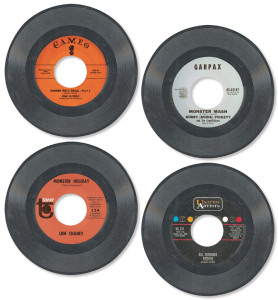
Wonderful things happened in the 1950s: TV dinners, the Hula Hoop, Marilyn Monroe. But it’s no exaggeration to say the ’50s was also a time of social paranoia.
The decade’s defining event, what history calls the Red Scare, fostered an environment in which mainstream Americans were often mistrustful of anything different, anything that was “other.”
As the Army-McCarthy hearings drilled into the proletariat: You are either one of us, or one of them.
This atmosphere created the perfect storm for the birth of rock ’n’ roll, which was all about rebellion and sex and crazy dances.
When was rock ’n’ roll born? That’s a toughie. As you watch the 1938 Andy Hardy movie “Judge Hardy’s Children,” and Andy disrupts a boring cotillion by coaxing the band into playing swing, the resulting joyful chaos sure looks and sounds an awful lot like rock ’n’ roll.
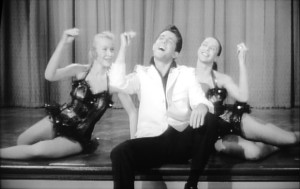
Historians have their theories, and their disagreements, as to the moment rock ’n’ roll was hatched. As for me, I point to July 9, 1955, the day “Rock Around the Clock” by Bill Haley and the Comets became the first song of this embryonic type to hit #1 on the Billboard sales chart. Not just because of the Billboard thing. The song itself seemed like an irrevocable call-to-arms for this new music: “We’re gonna rock, rock, rock ’til broad daylight.”
So — if you’ll accept for the moment my theory that rock was born in earnest in 1955 — the Monster Craze followed by a mere two years. Neither phenomenon exactly won universal parental approval. Ed Sullivan famously wouldn’t allow Elvis Presley’s hips to be seen on his Sunday night variety show. Monsters were pointy-teethed, neckbolt-wearing pariahs among the Parent Teacher Association set. It’s no wonder rock ’n’ roll and monsters formed their little unholy alliance.
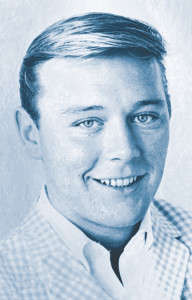
Another question for historians: When was the first song to combine monsters and rock? Certainly, “Monster Mash” by Bobby (Boris) Pickett — that freaky-funny novelty hit with references to “Wolf Man, Dracula and his son,” which went to #1 in 1962 — is the one we remember best.
But there are many precedents.
As more and more living rooms became TV-set-equipped during the 1950s, families were vanishing from movie theaters so they could watch their tiny, blurry screens at home. Fine and dandy for Daddy, Mommy and the tykes, but teenagers needed to get away from their square relations. Drive-in theaters became the perfect modern surrogate for Lovers’ Lane. Cars provided cover for fumblings in the dark, and movie soundtracks handily masked any heavy breathing.
Thus, the drive-in market — specifically targeted at teens — was up and running.
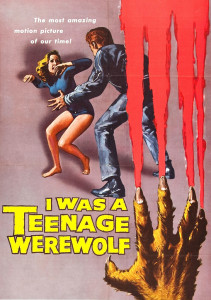
Big movie stars? Who needs ’em? Independent movie companies, chiefly American International Pictures (AIP), instead garnered box office with sensational titles like “I Was a Teenage Werewolf” and “Invasion of the Saucer Men” (both 1957). For drive-in movies, the focus was on genre, not star power, and the rejuvenated monster genre was riding high. Increasingly, teenagers were cast as the stars of these movies. (It was a win-win for AIP, enhancing teen relatability as it shrank payroll.) And what kind of music did teens like to listen to? Thus, dipso facto, rock ’n’ roll songs began to pop up in monster movies.
“I Was a Teenage Werewolf,” which ignited the whole teen monster trend, interpolated rock ’n’ roll out of the box. Ken Miller — as a pal of Michael Landon’s title terror — sang “Eeny, Meeny, Miney, Moe” (“I wanna girl with a lotta dough”), perhaps the earliest example of a rock ’n’ monsters coupling. Miller’s voice has a pleasant ring, but his singing is incessantly behind the beat. He explained why in 2002.
“I got to sing a little song there, which was unfortunately out of sync,” Miller told me with a laugh. “That’s what happens when you’re doing a film that doesn’t have a big budget. They never did put it in sync.”
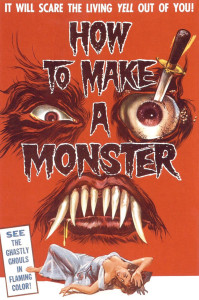
Rock ’n’ roll songs are also performed in the monster movies “Blood of Dracula” (1957), “Earth vs. the Spider” (1958), “Frankenstein’s Daughter” (1958) and “The Giant Gila Monster” (1959). In “How to Make a Monster” (1958), John Ashley plays himself (as if, ha-ha, he is a celebrity outside of American International Pictures) singing “You’ve Got to Have Ee-Ooo” (it sounds like a fungus) surrounded by gyrating dancing girls.
Ah, but these films merely presented rock ’n’ roll songs within monster movies — as opposed to actually blending the genres. In real life, the genre-blending had already occurred.
“Dinner With Drac” by John Zacherle was released by Cameo Parkway on March 10, 1958, and went to #6. A sample lyric: “A dinner was served for three / at Dracula’s house by the sea / the hors d’oeuvres were fine, but I choked on my wine / when I learned that the main course was me!” (Yeah, Cole Porter, it ain’t.)
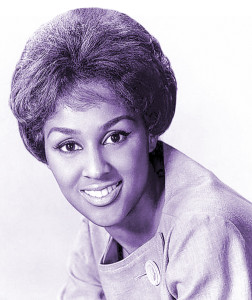
But the most enduring monster hit by far came along on Aug. 25, 1962, when Bobby (Boris) Pickett released “Monster Mash” (to which Darlene Love contributed backing vocals, by the by). As “Monster Mash” shot up the charts to #1, it seemed as if the whole world had become officially monster-crazy.
There were others, each more insufferable than the last. For the most part, the novelty monster-rock songs are pretty terrible, except for Pickett’s “Monster Mash,” which faithfully, and deservedly, gets played every Halloween at parties, taverns and on radio . . . and then gets put away for the next 364 days.
Music was changing; Bill Haley and Elvis gave way to the Beach Boys and the Beatles. Monster movies reflected this … and still sometimes put rock ’n’ roll songs on their soundtracks. At least, some ironic monster movies did.

Such as the low-budget, but surprisingly clever, beach-movie parody “The Horror at Party Beach” (1964). The Del-Aires, a surf-rock quartet, wear striped shirts stolen from the Beach Boys. One of them looks like Ernie from “My Three Sons.” They rock the beach until the trampy girl who cavorted with the bikers gets eaten by a mutated fish monster, ending all fun in the sun.
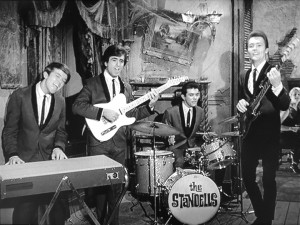
In TV land, the Standells rocked 1313 Mockingbird Lane while playing themselves on “The Munsters,” in Episode 26 of Season 1 (“Far Out Munster”). It aired on March 16, 1965, so Beatlemania was in full swing. The very Californian Standells did everything possible to remind you of the very British Beatles. They played two songs, “Come On and Ringo” (with lots of “yeahs”) and a cover of “I Wanna Hold Your Hand” that did not have John, Paul, George and Ringo shaking in their Beatle boots.
At first, the adult Munsters don’t dig the Standells, but little Eddie is hip. “Hey, Dad,” Eddie squeaks, “those neat guys are the Standells!” Herman finally admits: “They are rather razzmatazz. You know, they’re almost as good as Kate Smith.”
Soon after, the Munsters’ rivals, “The Addams Family,” did a bit of rockin’ and rollin’ of their own. In Episode 33 of Season 1, “Lurch the Teen Idol” (airdate: May 14, 1965), the Addams’ butler (Ted Cassidy) grunts “Go, go, baby!” at his harpsichord — and scores a hit record. In real life, Cassidy put out a novelty single on Capitol Records, “The Lurch,” and performed it on TV’s “Shindig” while dancing, Lurch style, with teenaged girls. It’s every bit as wince-worthy as it sounds.

“The Lurch” — insipid spoken-word mixed with okay contemporary pop — is excruciating to listen to. And yet, it brings a smile to your face. Those demon children, rock ’n’ roll and monsters, still couldn’t get enough of each other.
What did it all mean? Where did it all lead? I have a zany theory. Would there have been Black Sabbath, Alice Cooper, Kiss, Rob Zombie or death metal without “Dinner With Drac” and “Monster Mash”? Eh, probably.
But all of these acts have acknowledged the influence horror films had on their art. (Black Sabbath named itself after a Boris Karloff movie, fer cryin’ out loud.)
I believe you can draw a line from those early monster-rock pioneers, however silly, to their wild-maned, leather-clad, studs-bedecked descendants. You’ve gotta slither before you can stalk.
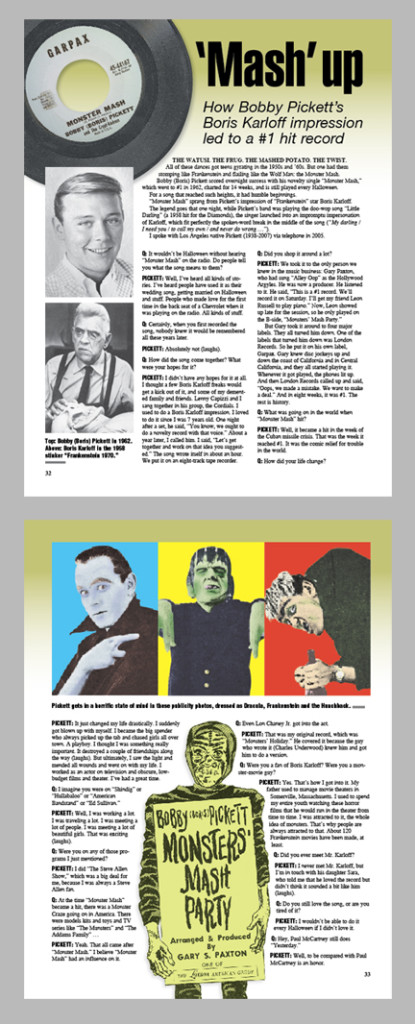 Bobby “Boris” Pickett on the genesis of “Monster Mash”:
Bobby “Boris” Pickett on the genesis of “Monster Mash”:
“Lenny Capizzi and I sang together in his group, the Cordials. I used to do a Boris Karloff impression. I loved to do it since I was 7 years old. One night after a set, he said, ‘You know, we ought to do a novelty record with that voice.’
“About a year later, I called him. I said, ‘Let’s get together and work on that idea you suggested.’ The song wrote itself in about an hour. We put it on an eight-track tape recorder.
“We took it to the only person we knew in the music business: Gary Paxton, who had sung ‘Alley Oop’ as the Hollywood Argyles. He was now a producer. He listened to it. He said, ‘This is a #1 record. We’ll record it on Saturday.’
“Gary took it around to four major labels. They all turned him down. One of the labels that turned him down was London Records. So he put it on his own label, Garpax. Gary knew disc jockeys up and down the coast of California and in Central California, and they all started playing it. Whenever it got played, the phones lit up. And then London Records called up and said, ‘Oops, we made a mistake. We want to make a deal.’ And in eight weeks, it was #1.”